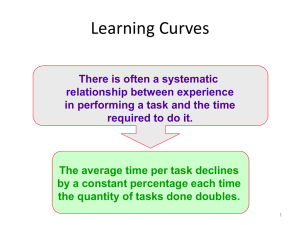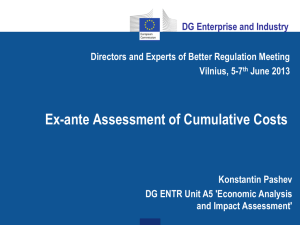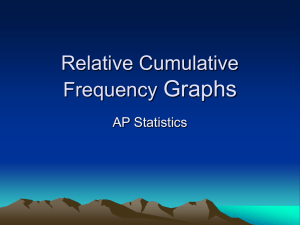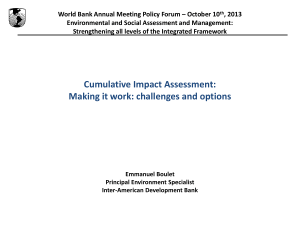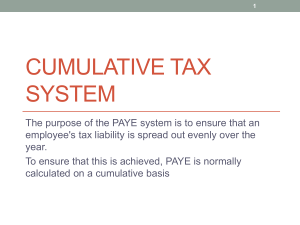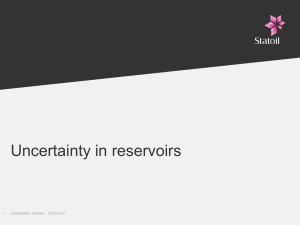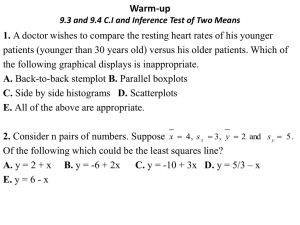Modelling cumulative risk
advertisement
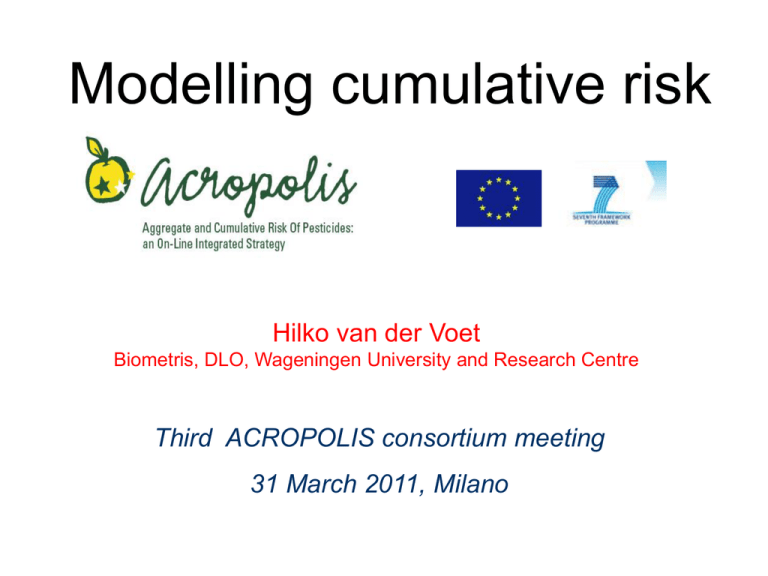
Modelling cumulative risk Hilko van der Voet Biometris, DLO, Wageningen University and Research Centre Third ACROPOLIS consortium meeting 31 March 2011, Milano Contents • State of the art for modelling of single pesticides – Exposure assessment – Risk assessment • ACROPOLIS: modelling for multiple pesticides in a Common Assessment Group – Cumulative exposure assessment – Cumulative risk assessment Risk assessment integrated risk assessment A.G. Renwick et al. (2003) Exposure Assessment MCRA Individual Margin of Exposure 1 – MCRA 7 calculates exposure distributions for single compounds – Percentiles and number of people exceeding a limit value (e.g. ARfD) – Acute or chronic risks – Processing factors, variability factors, modelling of non-detects, covariates, ... – Drill-downs – Uncertainty analysis 10 100 1000 10000 Risk Assessment: the IPRA model van der Voet & Slob (2007), Risk Analysis 27: 351-371 Individual Margin of Exposure 1 10 100 1000 10000 Individual Margin of Exposure Exposure assessment and hazard characterisation combined into an integrated probabilistic model (IPRA) Margin of Exposure replaced by Individual Margin of Exposure (IMoE) Analysis of variability and uncertainty kept separate Proposed instruments for risk managers: IMoE safety bar, IMoEp1 and/or IMoEL Individual Margin of Exposure 1 10 IMoEL 100 1000 10000 IMoEp1 Van der Voet et al. (2009) Example: Comparison of risks • Decisions of fungicide use are an example of risk-benefit analysis – Fungicides may have toxic effects (hazard) – Fungicides may reduce risk of mycotoxin production (benefit) Individual Margin of Exposure 1 10 100 1000 10000 100000 1000000 10000000 5% effect on BW from mycotoxin 5% effect on erythrocyte count from fungicide 50% cases of hepatocytomegaly from fungicide Muri et al. (2009) Cumulative assessments • Common Assessment Groups refer to multiple compounds with for the purpose of the assessment will be assumed to have the same health effect • Potency differences are captured in Relative Potency Factors (RPFs) – Estimated from data – Therefore RPF estimates will be not exactly known but uncertain • Estimating RPFs from doseExample Organophosphates et al. 2009) response(Bosgra data – Dose-response data EPA – Parallel curves fitted by PROAST Probabilistic models cumulative exposure • It is important to describe the variation between persons (Person Oriented Models) in the relevant population • Which population is used? – Models with predefined populations or subpopulations thereof: e.g. US models DEEM/Calendex, LifeLine, CARES, SHEDS – Model applicable to user-defined populations: Acropolis model based on MCRA Data for cumulative exposure • Consumption data: national survey data • Residue data: need to collect at the level of individual samples so that correlations between pesticides are represented – use of pesticides A and B may be exclusive – or they may be used always together – or anything in between ... • Problem: residue data matrix contain many missing values (MVs) and non-detects (NDs) Cumulative exposure: residue data non-detect (< 0.05) missing value (nonmeasurement) positive value Cumulative exposure assessment In the EFSA triazole project (van Klaveren et al. 2009) two approaches for cumulative exposure assessment using single-residue modelling methods were compared: 1. First add, then analyse Calculate RPF-weighted sum of concentrations per sample then exposure assessment for ‘single’ compound 2. First analyse, then add Parallel exposure assessment runs for the compounds then RPF-weighted summing of intakes using same sequence of simulated consumers Approach 1: First add, then analyse Assumes that the total set of samples is representative for a food Advantage: – incorporates correlations between compounds • negative correlation: lower exposure • positive correlation: higher exposure • Disadvantage: – requires data for all compounds in all samples • for non-measured compounds effectively a concentration 0 is assumed • estimated exposure may be too low Approach 2: First analyse, then add Assumes that per compound the set of samples with measurements is representative for a food • Advantage: – each compound may have its own set of samples • Disadvantage: – does not incorporates correlations between compounds Example triazoles van Klaveren et al. (2009) • Netherlands: not much difference – most samples were analysed for most triazoles • France: Approach 2 more conservative – many samples analysed for only part of triazoles ACROPOLIS approach • Combine advantages of Approaches 1 and 2 by – Fitting a multivariate model to the combined residue data – Allow for patterns of missing information – Allow for measurements below a Limit of reporting (non-detects) • Detailed models are under investigation – Correlation between pesticides may exist • Regarding the use frequencies • Regarding the resulting concentrations – We know fairly certain that each pesticide is only used in a fraction of cases, so there must be many ‘true zeroes’ – Some models may allow the use of additional data from Pesticide Usage Surveys FERA PUS data. Example : Wheat (GB, 2008) 1400 • 800 • 600 • 200 400 • • 0 Number of fields 1000 • 1200 Wheat 1 2 3 4 Number of triazoles per field 5 6 Proportion of wheat fields treated with a triazole is 0.95 12 different triazoles are used for wheat in GB 111 different combinations of up to 6 triazoles used Most fields use a combination of 2 or 3 triazoles Only 25 fields were treated with 6 different triazoles Conclusion: many of the nondetects and missing values must be true zeroes Example : Wheat GB, 2008 (FERA) Wheat Overall Usage 250 • 150 • 100 Triadimenol Triadimenol Tetraconazole Tetraconazole Tebuconazole Tebuconazole Prothioconazole Prothioconazole Propiconazole Propiconazole Metconazole Metconazole Flutriafol Flutriafol Flusilazole Flusilazole Fluquinconazole Fluquinconazole Epoxiconazole Epoxiconazole Cyproconazole Cyproconazole 0 Prothioconazole is applied most (in total 272.88 kg/ha) either individually (2 fields) or in combination (1465 fields) Prothioconazole used in GB but not in The Netherlands • Suggests GB data for wheat may not be appropriate to make assumptions for some countries in Europe • Data available for other countries? 50 Bromuconazole Bromuconazole Total triazole applied (kg/ha) 200 Example modelling of correlation simulated from bivariate normal distribution, means 3 and 7 sds 2 and 3 correlation 0.8 Which distributions are appropriate? • We need a statistical model for cumulative exposure • Options: – multivariate lognormal (convenient) – Mixture of true zeroes and lognormal – other parametric or non-parametric multivariate distributions Uncertainty approaches • Uncertainty about inputs and model form uncertainty about quantities of interest – e.g. fraction of population exceeding a limit value • Sources of information on uncertainty – Data, e.g. implicit in small sample or s.e. from literature – Expert judgment (needs ‘elicitation’) • Main approaches to address uncertainty: – modelling based on available data or expert judgment – qualitative assessment of uncertainties by experts, summarized in uncertainty tables Quantitative and qualitative approaches Uncertainty PoCE 35 % contribution 30 25 20 15 10 5 0 MC cons conc proc anim al Uncertainty source inter intra Updated view on data needed for cumulative assessments • Consumption survey data • Residue monitoring data or field trial data (preregistration) • Food conversion (linking food as eaten to food as measured) • Data on processing, unit variability • Pesticide usage data • Dose response data for critical health effect to estimate RPFs (or for direct use) Cumulative Risk Assessment • For integrating exposure assessment and hazard characterisation two approaches are possible: – Two-step approach: • First, perform cumulative exposure assessment using RPFweighted sum • Secondly, calculate MoE or IMoE distribution using toxicology data for the index compound • Examples in Bosgra et al. (2009), Müller et al. (2009) – One-step approach: • single-pesticide IMoE distributions from a cumulative IPRA analysis can be directly combined into a cumulative IMoE distribution (for details see van der Voet et al. 2009) • This would circumvent the explicit calculation of RPFs Conclusions • Modelling cumulative exposure and risk already possible, further developed in ACROPOLIS • Patterns and amount of missing values and nondetects may be a problem • Pesticide usage survey data may be useful • Future: Integrated models may replace separate estimation of RPF and use of RPF models • ACROPOLIS system: bring many data together in one platform, accessible to all stakeholders
